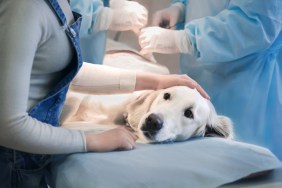Megaesophagus in dogs is a condition where food and liquids accumulate in the canine’s esophagus. This means that the food and liquid cannot make their way down to the dog’s stomach, which in turn causes the dog to regurgitate the contents of the esophagus.
In some cases, this can lead to aspiration pneumonia. If you see symptoms in your dog, then you must consult your veterinarian for a proper diagnosis and course of treatment.
Here’s what you should know about the symptoms, causes, and treatments for megaesophagus in dogs.
Symptoms Of Megaesophagus In Dogs
Megaesophagus in dogs can be a tricky condition to diagnose, partly due to the wide range of symptoms.
Some of the most common symptoms include:
- Regurgitating food and liquid
- Showing less of an appetite
- Coughing
- Weight loss
- Bad breath
- Drooling more than usual
Causes Of Megaesophagus In Dogs

The causes of megaesophagus in dogs depend on whether canines are suffering from acquired megaesophagus or congenital megaesophagus.
In cases of acquired megaesophagus, there is no known accepted cause; although, an inflamed esophagus, an infection, or a tumor could be behind the condition.
In cases of congenital megaesophagus, the dog is born with the issue. It’s hereditory in the Miniature Schnauzer and Wire Haired Fox Terrier dog breeds.
Certain other dog breeds are also more likely to suffer from the condition, including Great Danes, Labrador Retrievers, and Newfoundlands.
Treatments For Megaesophagus In Dogs
If your suspects your dog has megaesophagus, they’ll ask you about any relevant symptoms and carry out a physical examination of the dog. They’ll pay special attention to the throat area and may also use X-rays to see how dilated the esophagus has become.
When it comes to treating the condition, management is key. This might involve switching to a high calorie diet, and focusing on the consistency of the food being eaten. A vet might recommend an upright feeding set up with a Bailey chair to support the dog in the proper position during meal times.
In more extreme cases, vets may consider placing feeding tubes.
Does your dog have megaesophagus? How do you and your vet manage the condition? Tell us all about it in the comments below!









